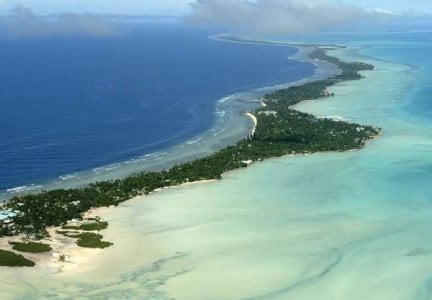Are your favourite Aussie holiday islands about to be off-limits? Here’s what you need to know
By
Danielle F.
- Replies 0
As the winter chill sets in across Australia, many of us start dreaming of a tropical escape—perhaps to the sun-drenched islands of the South Pacific, where the water is warm, the sand is soft, and the worries of daily life seem to melt away. But if you’ve been putting off that dream trip to places like Vanuatu, Tuvalu, or Micronesia, it might be time to bump it up your bucket list. The sobering truth is that these beloved holiday destinations may not be around for much longer.
Why the rush? The islands are disappearing
It’s not just a travel agent’s sales pitch—scientists are sounding the alarm that rising sea levels, driven by climate change, are threatening to swallow up some of the world’s most beautiful low-lying islands. Recent research led by Durham University has revealed that the melting of ice sheets in Antarctica and Greenland is happening faster than previously thought, and the consequences are dire for the South Pacific.
Global warming has already pushed average temperatures 1.2 degrees above pre-industrial levels. While the Paris Agreement aims to cap warming at 1.5 degrees, even this ambitious target may not be enough to halt the accelerating melt of the world’s largest ice sheets. The result? Sea levels could rise by several metres over the coming centuries, with some scientists warning that increases of up to one centimetre per year could occur within the lifetime of today’s young people.
For the islands of Vanuatu, Tuvalu, and Micronesia—places many Aussies have visited or dream of visiting—this is a looming catastrophe. These nations are made up of low-lying atolls and islands, some barely a metre or two above sea level. As the ocean rises, these lands face the very real risk of being submerged, making them uninhabitable and, of course, off-limits for future holidays.
It’s not just about losing a holiday spot, either. Around 230 million people worldwide live in areas vulnerable to just one metre of sea level rise. For many Pacific Islanders, this isn’t a distant threat—it’s a daily reality, with saltwater already encroaching on farmland, contaminating drinking water, and forcing communities to consider relocation.
The bigger picture: Why is this happening?
The main culprit is the continued burning of fossil fuels—coal, oil, and gas—which releases greenhouse gases into the atmosphere and traps heat. Despite global agreements and net-zero targets, countries like Australia remain among the world’s largest fossil fuel exporters. In fact, in the 2023-24 financial year, Australian taxpayers contributed a staggering $14.5 billion in subsidies to fossil fuel projects.
Meanwhile, some major economies are backtracking on climate commitments, further slowing global progress. The result is a world that’s warming faster than we can adapt, with rising seas just one of many consequences.
What can be done?
The scientists behind the latest research are clear: this is an emergency that demands immediate action. Dr. Chris Stokes, the lead author of the study, warns that unless we make rapid and drastic cuts to emissions, the costs—both human and financial—will only grow. Building sea walls and relocating entire communities are expensive and, for many nations, simply unaffordable.
While climate action can be politically contentious, the alternative is far worse. As Dr. Stokes puts it, 'Sea level rise is not going to go away, this is not something we can push under the carpet, it’s going to get worse and worse.'
What does this mean for Aussie travellers?
If you’ve always wanted to visit the South Pacific, now is the time. Not only will you experience these incredible cultures and landscapes, but your tourism dollars can also help support local communities facing an uncertain future. And while you’re there, take the time to learn about the challenges these nations face—many islanders are eager to share their stories and raise awareness about the impacts of climate change.
How Can You Help?

Have you visited any of these beautiful islands? Are you worried about the future of your favourite holiday spots? What do you think Australia should do to help protect our neighbours in the Pacific? We’d love to hear your thoughts and stories—share them in the comments below!
Why the rush? The islands are disappearing
It’s not just a travel agent’s sales pitch—scientists are sounding the alarm that rising sea levels, driven by climate change, are threatening to swallow up some of the world’s most beautiful low-lying islands. Recent research led by Durham University has revealed that the melting of ice sheets in Antarctica and Greenland is happening faster than previously thought, and the consequences are dire for the South Pacific.
Global warming has already pushed average temperatures 1.2 degrees above pre-industrial levels. While the Paris Agreement aims to cap warming at 1.5 degrees, even this ambitious target may not be enough to halt the accelerating melt of the world’s largest ice sheets. The result? Sea levels could rise by several metres over the coming centuries, with some scientists warning that increases of up to one centimetre per year could occur within the lifetime of today’s young people.
What does this mean for your favourite islands?For the islands of Vanuatu, Tuvalu, and Micronesia—places many Aussies have visited or dream of visiting—this is a looming catastrophe. These nations are made up of low-lying atolls and islands, some barely a metre or two above sea level. As the ocean rises, these lands face the very real risk of being submerged, making them uninhabitable and, of course, off-limits for future holidays.
It’s not just about losing a holiday spot, either. Around 230 million people worldwide live in areas vulnerable to just one metre of sea level rise. For many Pacific Islanders, this isn’t a distant threat—it’s a daily reality, with saltwater already encroaching on farmland, contaminating drinking water, and forcing communities to consider relocation.
The bigger picture: Why is this happening?
The main culprit is the continued burning of fossil fuels—coal, oil, and gas—which releases greenhouse gases into the atmosphere and traps heat. Despite global agreements and net-zero targets, countries like Australia remain among the world’s largest fossil fuel exporters. In fact, in the 2023-24 financial year, Australian taxpayers contributed a staggering $14.5 billion in subsidies to fossil fuel projects.
Meanwhile, some major economies are backtracking on climate commitments, further slowing global progress. The result is a world that’s warming faster than we can adapt, with rising seas just one of many consequences.
What can be done?
The scientists behind the latest research are clear: this is an emergency that demands immediate action. Dr. Chris Stokes, the lead author of the study, warns that unless we make rapid and drastic cuts to emissions, the costs—both human and financial—will only grow. Building sea walls and relocating entire communities are expensive and, for many nations, simply unaffordable.
While climate action can be politically contentious, the alternative is far worse. As Dr. Stokes puts it, 'Sea level rise is not going to go away, this is not something we can push under the carpet, it’s going to get worse and worse.'
What does this mean for Aussie travellers?
If you’ve always wanted to visit the South Pacific, now is the time. Not only will you experience these incredible cultures and landscapes, but your tourism dollars can also help support local communities facing an uncertain future. And while you’re there, take the time to learn about the challenges these nations face—many islanders are eager to share their stories and raise awareness about the impacts of climate change.
How Can You Help?
- Travel responsibly: Support eco-friendly operators and respect local customs.
- Reduce your carbon footprint: Consider offsetting your travel emissions and making sustainable choices at home.
- Stay informed and engaged: Support policies and leaders committed to real climate action.
- Share your experiences: Talk to friends and family about what you’ve learned and why these places matter.
Key Takeaways
- Popular holiday destinations in the South Pacific like Vanuatu, Tuvalu, and Micronesia could be lost within the next century due to rising sea levels from melting ice sheets.
- Scientists warn that sea levels may rise by up to one centimetre per year within the lifetime of young Australians, putting 230 million people worldwide at risk of displacement.
- Despite Australia’s net-zero ambitions, the country continues to approve new fossil fuel projects and provided $14.5 billion in subsidies to them during 2023-24, contributing further to climate change.
- Experts describe the situation as an 'emergency', urging global leaders to take immediate and drastic action to reduce emissions, as delaying will only increase the cost and impact of sea level rise.








